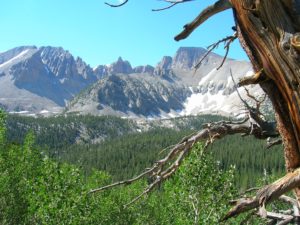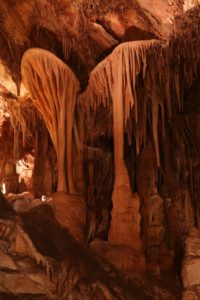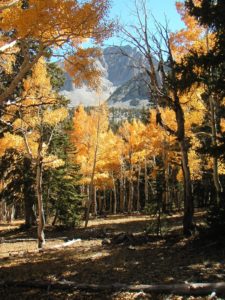GREAT BASIN NATIONAL PARK
By Glenda Brehm
 We drove nearly four hundred miles from the base of the eastern slope of California’s Sierra Nevada Mountain Range to the far eastern side of Nevada as our car cut across a small piece of the immense desert known as the Great Basin. This vast expanse of barrenness covers the greater part of Nevada, half of Utah, and slices of California, Oregon, Idaho, and Wyoming. Our destination—Great Basin National Park—provided a remote oasis amid the arid, dusty, and parched land.
We drove nearly four hundred miles from the base of the eastern slope of California’s Sierra Nevada Mountain Range to the far eastern side of Nevada as our car cut across a small piece of the immense desert known as the Great Basin. This vast expanse of barrenness covers the greater part of Nevada, half of Utah, and slices of California, Oregon, Idaho, and Wyoming. Our destination—Great Basin National Park—provided a remote oasis amid the arid, dusty, and parched land.
On a golden autumn day my husband and I found ourselves immersed in God’s creation—a surprising display of nature way more diverse than any we had ever encountered. Psalm 24:1 aptly describes our surroundings at this park: “The earth is the Lord’s, and the fulness thereof; the world, and they that dwell therein” (KJV). The sights gifted us with more than immense landscapes; it actually included subterranean wonders beyond our imagination.
 With 40 known caves in the area, only Lehman Caves and one other are open to the public. Laced with more than three hundred rare cave formations called helictites, the dark caverns display intricate straws of stone in all sorts of angles appearing as if they were grown in zero gravity. Other unique cave formations include folia, bulbous stalactites, anthodites, and shields.
With 40 known caves in the area, only Lehman Caves and one other are open to the public. Laced with more than three hundred rare cave formations called helictites, the dark caverns display intricate straws of stone in all sorts of angles appearing as if they were grown in zero gravity. Other unique cave formations include folia, bulbous stalactites, anthodites, and shields.
Along with cave exploration, plenty of other outdoor attractions (including hiking, horseback riding, rock climbing, cross-country skiing, fishing, camping, wildlife viewing,
and ranger-led talks) invite visitors to experience the park in a myriad of ways. From the valley floor at 4,000 to 5,000 feet elevation where sagebrush blankets the hot, dry ground to Wheeler Peak at 13,065 feet claiming the title as the second highest peak in Nevada and home to the state’s only active glacier, variety abounds in terrain, temperature, vegetation, creatures, and vistas.
But the stunning scenery doesn’t end at nightfall. Great Basin National Park boasts the darkest skies in the lower 48 states yielding a heavenly display of endless stars, constellations, and other astronomical wonders. The park has its own observatory for scientific research, as well as for education and outreach. Visitors can view imagery from the main and secondary telescopes, and every year the park hosts an astronomy festival for enthusiasts who want to explore the heavens. If you don’t have a telescope, one will be provided.
Despite all these pursuits, mainly hiking attracted us to Great Basin National Park. With over sixty miles of developed trails, plenty of options prevail, but one particular hike lured me across the desert—The Bristlecone Trail where a grove of old twisted, age-sculpted trees stand tucked into the base of Wheeler Peak. Beginning at the end of the 12-mile Wheeler Peak Scenic Drive that ascends high above the Great Basin, we climbed amid the bright yellow desert sage of autumn that faded into lush green forests and meadows.
 Higher still, the aspens were starting to turn into their signature hue, and in a few days the mountainside would be aflame with gold! As we drove along the twists and turns, many spectacular views of the park filled our vehicle window, and I reflected upon the verse in Psalm 96:12 that says, “Let the field be joyful, and all that is therein: then shall all the trees of the wood rejoice” (KJV). I thought this applied not only to the surrounding evergreens but also to the ancient trees patiently waiting our arrival. Imagine how much a tree could rejoice while living for several thousand years!
Higher still, the aspens were starting to turn into their signature hue, and in a few days the mountainside would be aflame with gold! As we drove along the twists and turns, many spectacular views of the park filled our vehicle window, and I reflected upon the verse in Psalm 96:12 that says, “Let the field be joyful, and all that is therein: then shall all the trees of the wood rejoice” (KJV). I thought this applied not only to the surrounding evergreens but also to the ancient trees patiently waiting our arrival. Imagine how much a tree could rejoice while living for several thousand years!
At the end of the road was the trailhead that leads us 1.4 miles up to the secluded forest. The 600-foot climb started at an elevation of 9,800 feet amid thin, dry air that did not hinder our awe of the majestic surroundings. All around us were mountains and valleys and peace and quiet. It reminded me of the first part of Psalm 72:3 that says, “The mountains shall bring peace to the people” (KJV), which afforded a meaningful way to prepare us for the special treat ahead.
Although the trail continued on to the Wheeler Peak Glacier, we chose the small, dated grove as our destination. Upon our arrival the scene felt as if we had opened and entered a doorway while leaving the modern world behind. Slowly I crept into the seemingly secret garden of very old trees, chiseled by time, wind, and other harsh elements. I let myself become immersed in this wonderfully aged creation.
This was no ordinary forest where tall trees grow from a lush woodland floor to provide shade to weary travelers. Rather, the roots of these stunted, gnarled, bare-barked trees clung to the rocks and boulders, eking out whatever nutrients and moisture their thick roots could find. The only sound I could hear was the soft whisper of the wind whistling through other varieties of pines surrounding the bristlecones. In the far distance were the faint voices of other hikers who had ventured into this time capsule.
Many bristlecone pines sprouted thousands of years ago with the oldest along the trail being 3,200 years of age, and it is still growing today! Imagine being born around 1200 B.C. in the time of the biblical judges or perhaps Deborah or Gideon.
 All alone I leisurely walked among the trees, stopping at each one to marvel at its rugged character and persevering tenacity. I took my hand and gently moved it down the smooth bark of one particular tree. As I leaned against another stalwart specimen, I pondered that neither relentless trials of wind, elevation, sun, snow, or time hindered these trees from their determination to live. Although they looked battered, they were still alive.
All alone I leisurely walked among the trees, stopping at each one to marvel at its rugged character and persevering tenacity. I took my hand and gently moved it down the smooth bark of one particular tree. As I leaned against another stalwart specimen, I pondered that neither relentless trials of wind, elevation, sun, snow, or time hindered these trees from their determination to live. Although they looked battered, they were still alive.
Some might think they appear grotesque without all their needles. To me their exposed bark and twisted limbs reaching toward the azure sky exhibited captivating works of art. King Solomon described my feelings best in Ecclesiastes 3:11, “He hath made every thing beautiful in his time: also he hath set the world in their heart, so that no man can find out the work that God maketh from the beginning to the end” (KJV). And when God speaks of wisdom in Proverbs 1:2, “To know wisdom and instruction: to perceive the words of understanding” (KJV), I wondered what wisdom I could obtain from observing such unique botanical specimens.
First, they herald longevity through perseverance. Through constant toil they endure and rarely tumble under the onslaught of natural hardship. To compensate for soil erosion, their big roots feed only the section of the tree directly above them, and when one root dies off, only the part of the tree on top of the root dies. The rest of the tree stays alive, revealing another amazing characteristic of the bristlecone pine!
I concluded these trees were designed by God to illustrate tenacity through adversity. As Christians we have the promise of 2 Corinthians 4:8, 9, “We are troubled on every side, yet not distressed; we are perplexed, but not in despair; persecuted, but not forsaken; cast down, but not destroyed” (KJV).
Life can be rough at times. I thought about the different trials of my past and possible challenges in the future and remembered that Christians have the hope and comfort of the promise found in 2 Corinthians 12:9, “My grace is sufficient for thee: for my strength is made perfect in weakness. Most gladly therefore will I rather glory in my infirmities, that the power of Christ may rest upon me. Therefore I take pleasure in infirmities, in reproaches, in necessities, in persecutions, in distresses for Christ’s sake: for when I am weak, then am I strong” (KJV). Perhaps the bristlecone pine is a reminder that through God’s grace we can continue to move ahead in life even among crippling ordeals by praying and feeding the inner man with God’s Word.
Second, these tough trees reminded me what it means to be patient. Not only do they live on in spite of harsh conditions, but the ones that grow at the highest elevation also grow slowly. They do not hurry. In some years the circumstances are so severe they don’t even add a growth ring to their wood. Such careful growth makes their timber very dense and resistant to insects, fungi, rot, and eroding terrain.
James 1:3, 4 tells us, “Knowing this, that the trying of your faith worketh patience. But let patience have her perfect work, that ye may be perfect and entire, wanting nothing” (KJV). I found it inspiring to learn that the trees that grow in the harshest conditions are the ones that live the longest. For them God determined it was advantageous to be patient and persevere.
My time in this surreal, summit garden ended too soon. The hike back down the mountain awaited me, and I had no choice but to leave this exquisitely ancient place and the spiritual pinnacle it affords. In gratitude and humility I joined the psalmist when he said, “I have considered the days of old, the years of ancient times” (Psalm 77:5, KJV), and I will remain blessed.
_________________________________________________________
Glenda Brehm writes from Schell City, Missouri, where she ponders the wonders of God’s creation and develops stories for readers of all ages.
Photos courtesy of the National Park Service



